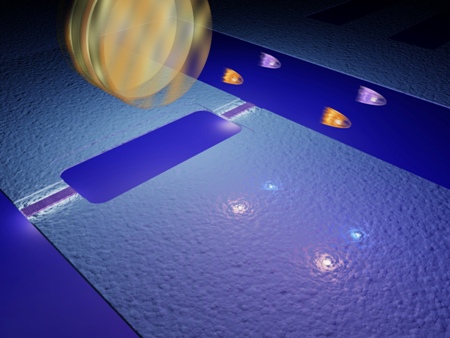Chalmers University of Technology researchers have been able to create light from vacuum. According to quantum mechanics principles, the vacuum is not totally empty, it contains particles that fluctuate between existence and non-existence continuously. These particles are also called as virtual particles, as their existence is very brief.
In 1970, Moore, a physicist, stated that if virtual photons were made to bounce off a mirror that moved at a speed nearly equivalent to that of light’s speed, then the photons will become real photons by leaving their virtual state. Real photons constitute light that can be measured. This unique phenomenon is called the Casimir effect.
 In the Chalmers scientists’ experiments, virtual photons bounce off a “mirror” that vibrates at a speed that is almost as high as the speed of light. The round mirror in the picture is a symbol, and under that is the quantum electronic component (referred to as a SQUID), which acts as a mirror. This makes real photons appear (in pairs) in vacuum. Credit: Philip Krantz, Chalmers
In the Chalmers scientists’ experiments, virtual photons bounce off a “mirror” that vibrates at a speed that is almost as high as the speed of light. The round mirror in the picture is a symbol, and under that is the quantum electronic component (referred to as a SQUID), which acts as a mirror. This makes real photons appear (in pairs) in vacuum. Credit: Philip Krantz, Chalmers
Scientists belonging to the Chalmers University of Technology have succeeded in creating measurable light, i.e. real photons. According to Professor of Experimental Physics at Chalmers, Per Delsing, getting a mirror to move at such high speeds was not possible, so they devised an alternative method. An electrical short circuit is normally used as a mirror for microwaves. The scientists changed the electrical distance to this electrical short circuit instead of changing the distance to a mirror. They used a superconducting quantum interference device (SQUID), which is a quantum electronic component, in the “mirror”. The SQUID exhibits high-sensitivity to magnetic fields. The scientists made the “mirror” to vibrate at a speed of nearly 25% of that of light’s speed, by varying the magnetic field direction many billions of times within a second.
From the vacuum, photons emerged in pairs, which the scientists measured as microwave radiation. The researchers were also able to prove that the radiation had exactly the same properties as defined by quantum theory especially when photons are seen in pairs in this manner. During the experiment, the photons materialized because the “mirror” transferred a part of its kinetic energy to the virtual photons. Associate Professor of Theoretical Physics explained that even though various types of particles exist in vacuum, photons appear as they lack mass and require relatively less energy. Creating other particles, such as protons or electrons from vacuum will require more energy.
The appearance of photons in pairs can be useful in quantum information research and quantum computer development. This unique experiment provides more knowledge about vacuum fluctuations and other basic physical concepts. These “vacuum fluctuations” can be linked to the “dark energy” that controls the fast expansion of the universe. The Nobel Prize in Physics was awarded for discovery of this acceleration.